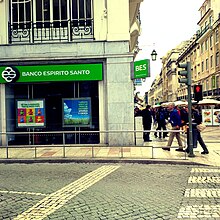Banco Espírito Santo
|
Branch in Lisbon
|
|
 |
|
| Sociedade Anónima | |
| Traded as | Euronext: BES |
| Industry | Financial services |
| Successor | Novo Banco |
| Founded | 1869 |
| Defunct | 2014 |
| Headquarters | Lisbon, Portugal |
|
Key people
|
Ricardo Salgado (CEO), Alberto Oliveira Pinto (Chairman) |
| Products | Retail and investment banking, insurance, asset management, venture capital |
| Revenue | €2.320 billion (2010) |
| Profit | €510.5 million (2010) |
| Total assets | €83.66 billion (end 2010) |
| Total equity | €7.476 billion (end 2010) |
|
Number of employees
|
9,860 (end 2010) |
| Subsidiaries | Banco Espírito Santo Angola (76%) |
| Website | www.bes.pt |
Banco Espírito Santo (BES) was a Portuguese bank based in Lisbon that on 4 August 2014 was split in two banks: Novo Banco, which kept its healthy operations, and a "bad bank" to keep its toxic assets.
It once was the second largest listed Portuguese bank and the ninth largest contributor to the PSI-20 index. BES was the second largest private financial institution in Portugal in terms of net assets (€80,700 million in March 2011), with an average market share of 20.3% in Portugal and 2.1 million clients.
On 3 August 2014, Banco de Portugal, Portugal's central bank, announced a €4.4 billion bailout of BES that heralded the end of BES as a private bank. The bailout was funded by the Portuguese Resolution Fund (Portuguese: Fundo de Resolução). The bank was split into a healthy bank, Novo Banco, while the toxic assets remain in the existing bank.
It has since been proven that the administration of BES led by Ricardo Salgado "disobeyed the Bank of Portugal 21 times, between December 2013 and July 2014", practising "painful acts of ruinous management".
Banco Espírito Santo’s origins began with the lottery, currency exchange, and securities business carried out by José Maria do Espírito Santo e Silva between 1869 and 1884. The first references to trading that the “patriarch of the only dynasty of Portuguese bankers” was undertaking was in the purchase and sale of lotteries, along with national and international transactions in loan securities, on his own account. This took place in his Casa de Cambio, situated in centre of Lisbon and which dated back to the second half of the 19th century (1869). Since then and until 1920, he founded a number of banking institutions, such as Beirão, Silva Pinto & Cª., (1884–1887), Silva, Beirão, Pinto & Cª. (1897–1911), J. M. Espírito Santo Silva (1911–1915), and J. M. Espírito Santo Silva & Cª. (1915).
In 1915, after the death of José Maria do Espírito Santo e Silva, these firms were dissolved and his heirs founded the Casa Bancária Espírito Santo Silva & Cª, which was transformed into a public limited-liability company in 1920 under the name Banco Espírito Santo with the bank, in this decade, managing to consolidate its position within the context of national banking by opening agencies and using a renewed management model.
...
Wikipedia
